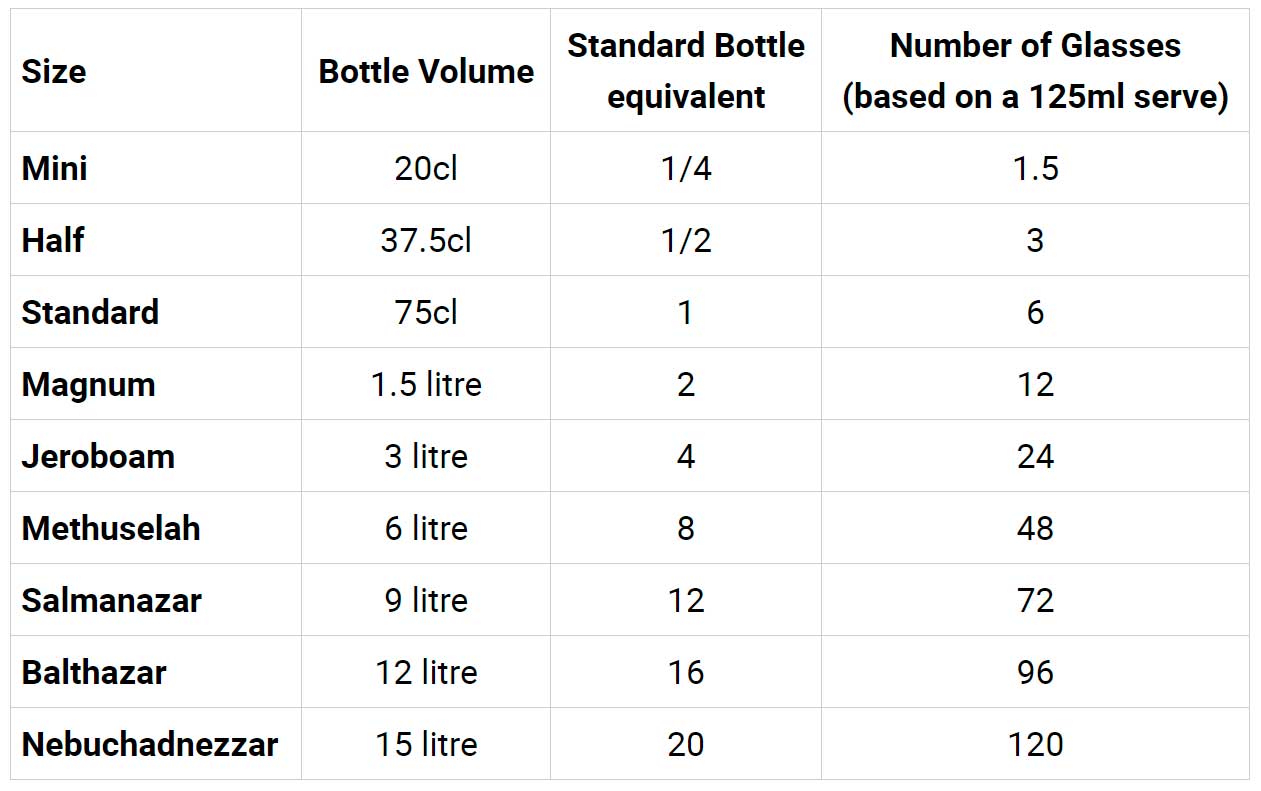Champagne Guide
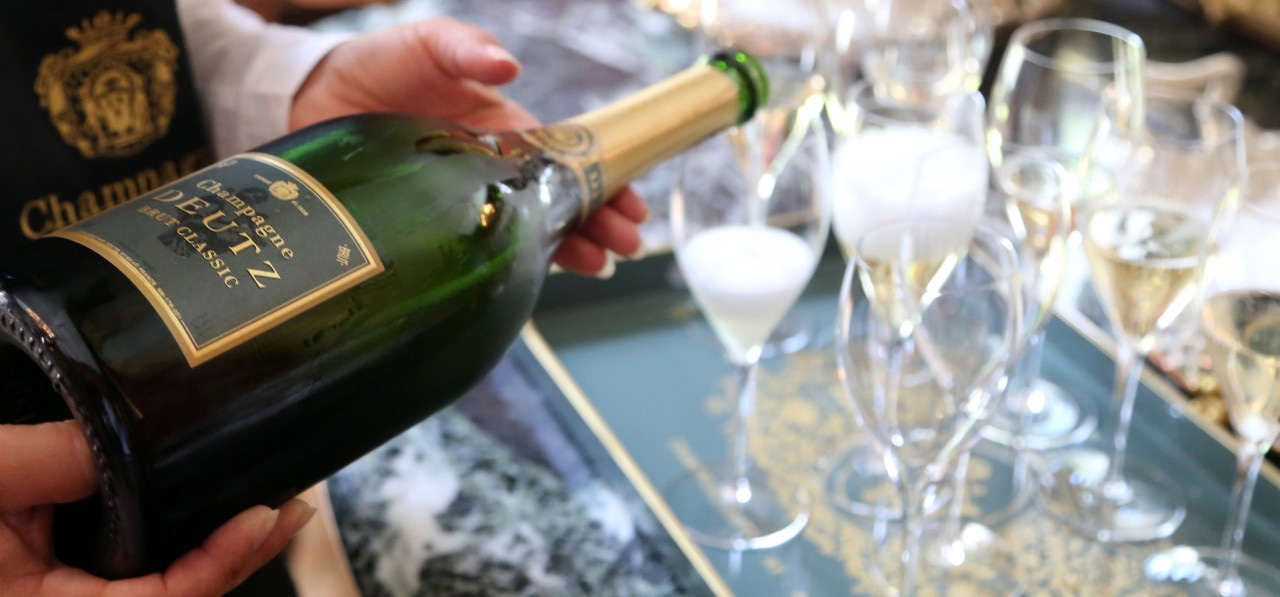
Background
Champagne is amongst the most prestigious of all the world's wines, synonymous with celebration, joyous occasions, moments of happiness, exquisite tastes and a feeling of luxury. Champagne is produced exclusively in the Champagne region of France, from which it takes its name. It’s a region with a winemaking heritage stretching back centuries. The area has long been highly acclaimed for its splendidly chalky soils and magical terroir.
Today, the word Champagne instantly brings to mind fantastic sparkling wines. However, it may be surprising to learn this is a relatively recent development in the history of the region. Vines were cultivated in Champagne at least as far back as Roman times with the first recorded vineyard belonging to St. Remi in the 5th century. For much of history, a wine that had bubbles was not regarded as a positive characteristic; the cold winters of northern France would often halt the fermentation of wine, leaving some residual sugar. When bottling time came around in the spring, the yeast would return to life and feed on the sugar once again. This time around, the carbon dioxide produced by the fermentation could not escape and instead simply dissolved into the wine and would not be released until the wine was later opened. The pressure created in the bottle caused its own set of problems and the commonplace occurrence of randomly exploding bottles or corks popping on their own led it to become known as "le vin do diable" or "the devil's wine".
The fashion for sparkling wines arose from the tastes of London's high society. Many of the most fashionable and powerful men from London's high society in the 17th century regularly ordered cases of wine from Champagne - wine intended to be still, though often found not to be so. These UK consumers saw the sparkling qualities of Champagne as desirable and thus began the research into the process before it was ever deliberately created. British merchants resurrected the use of cork stoppers - not used since Roman times - and also developed stronger glass bottles to contain the pressure. As the fashion spread to the courts of other European countries, the Champenois winemakers began to shift production from still to sparkling wine to capitalise on this trend.
Dom Perignon is often cited as the inventor of sparkling wines from Champagne. A French Benedictine monk, during the 17th century he conducted much research into the field of wine production and is widely regarded as an important pioneer in the industry. Since a fizzy wine was regarded unfavourably during Dom Perignon's time, he spent much time working to avoid the secondary fermentation process, favouring the red pinot noir grape for fine wine as white grapes had a greater tendency to re-ferment. He also developed methods to extract white wine from red grapes, recognising that the tannins in wine were derived from the skins, as well as refining the art of wine blending and advancing wine clarification. So while Dom Perignon did a great deal for the wine industry, he wasn't the pioneer that invented a sparkling wine.
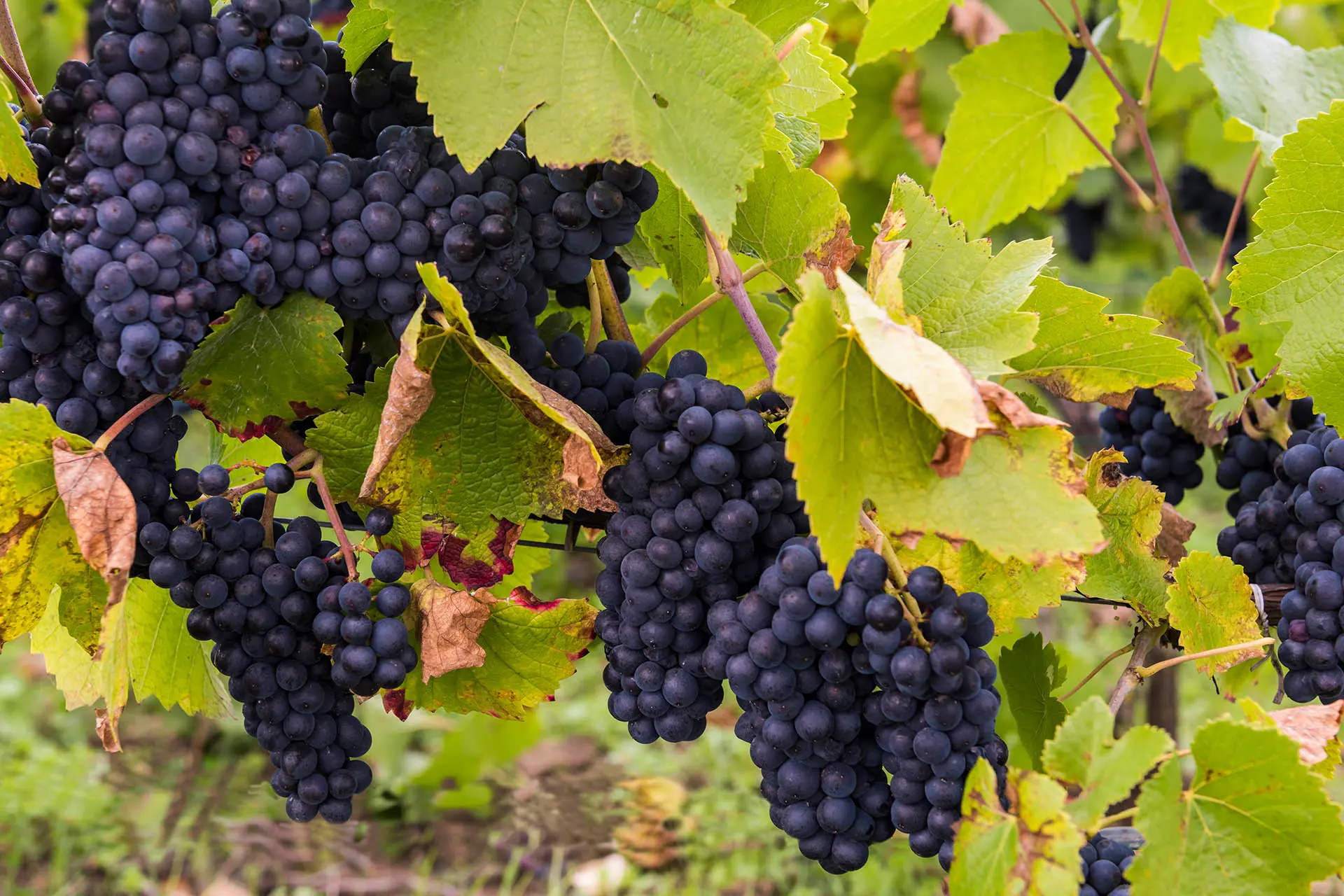
GRAPE VARIETIES
There are seven varieties of grape that are permitted for use under the Champagne appellation. Four of these are mostly included for historic reasons. The majority of Champagne houses will typically only use three main varieties.
Chardonnay
Chardonnay is the second most widely planted grape variety in France. Originally hailing from Burgundy in France, the grape today can be found in almost every wine growing region in the world for its ease of growing in a wide range of climates.
Chardonnay grapes are a key component of champagne wine, imparting much of the acidity to the wine, as well as biscuity flavours. Every major Champagne House has plantings of chardonnay.
The majority of champagne houses use chardonnay blended with other grapes, but when used on its own you get a unique style of Champagne, Blanc de Blancs (white wine from white grapes).
Pinot Noir
Pinot Noir is another classic Burgundy grape variety. Today it has become more widely planted in the Champagne region than in its native homeland. It is a difficult grape to grow, but it has an ability to in produce some of the finest wines in the world.
Although a black grape and traditionally used to produce red wines, in Champagne the Pinot Noir grapes undergo a much gentler pressing process which allows the white grape juice to be extracted without the colour and tannins the grape skin would typically impart.
Pinot Noir is also used to produce a still red wine which can then be blended with the white Champagne to produce Rosé Champagne. Some producers instead macerate the red Pinot Noir skins in the wine to produce Rosé this way.
Pinot Meunier
Pinot Meunier is the second black grape variety used in Champagne and generally the lesser-known of the primary Champagne varieties. Until recently, many Champagne houses put greater emphasis on the use of Chardonnay and Pinot Noir despite Pinot Meunier accounting for a third of all grapes grown in the region, but there is increasing acknowledgement for the rich body it contributes, as well as some of the fruitier flavours.
Like the closely-related Pinot Noir grape, Pinot Meunier produces a white wine when gently pressed, and indeed one particular style of Champagne, Blanc de Noirs (white wine from black grapes), is produced exclusively using either or both black grape varieties and no Chardonnay at all.
Other Grapes
The Appellation d'Origine Contrôlée for Champagne also permits the use of four other grapes: Pinot Gris, Petit Meslier, Pinot Blanc and Arbane. A vanishingly low quantity of these grapes is grown, with just around 1 hectare of Arbane vines grown in the entirety of France today. Some minor houses may produce Champagne from these grapes, but they are few and far between.
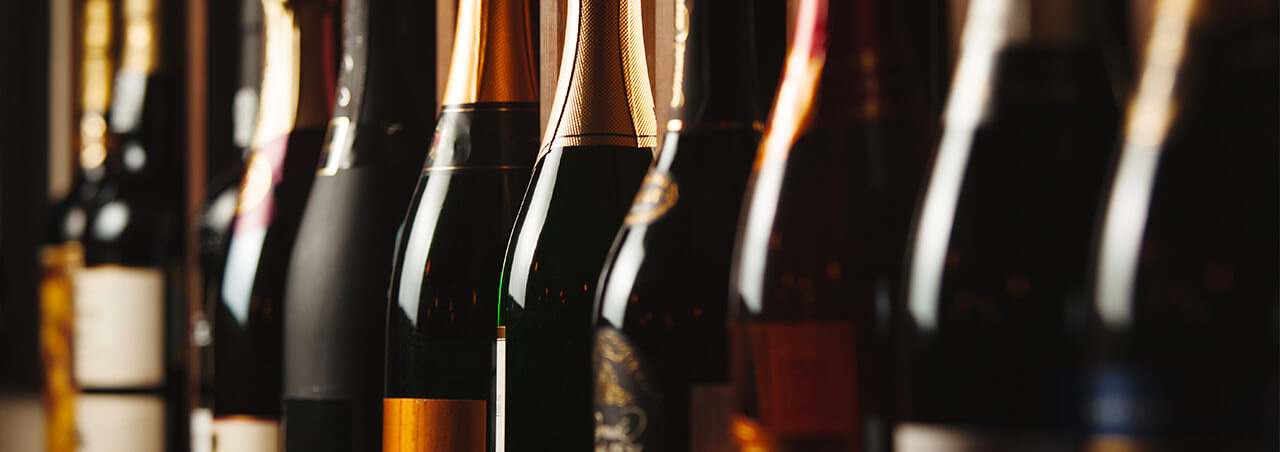
TYPES OF CHAMPAGNE
Non-Vintage (NV)
Around 90% plus of Champagne produced today is Non-Vintage. Non-Vintage Champagne means it is a blend of wines from different years. A large percentage of a Non-Vintage Champagne will be from a single year and then blended with wine held in reserve from previous years. By blending the wines together, Champagne houses can create a consistent style from year to year. Only 80% of a year’s harvest can be immediately used to make Champagne. The remaining 20% must be kept as reserve wine for future blends.
Vintage
Vintage Champagne is produced entirely from a single year's harvest and is only produced in years when the wine produced is considered to be of particularly high quality. Historically, vintages were only declared a few times a decade, when the conditions for growing grapes was excellent, but modern viticulture techniques have greatly improved the quality of harvests generally and vintage years are generally declared in six or seven years out of a decade. Vintage wines are required to be aged for at least three years but houses often age them longer, usually releasing a vintage at around five years old, though they will generally have good ageing potential and reach their peak at around eight to ten years old, so patience will be rewarded if such bottles are cared for and stored correctly. Some of the very best vintage Champagnes have even further ageing potential and some vintages are considered to be at their very finest at 30 to 40 years old.
Rosé
Rosé Champagne is a recent addition to the Champagne world, first created in the 1990s. There are two permissible methods by which Rosé Champagne can be created, either by maceration of black grape skins in white wine, or by the addition of still red Pinot Noir wine to the sparkling white wine. The addition of Pinot Noir is generally the preferred method as it can create a very consistent product from year to year, but some houses such as Laurent-Perrier opt for maceration.
Blanc de Blancs
Blanc de Blancs is a French term translating as "white from whites" and is used to describe Champagne created solely from Chardonnay grapes, or very rarely from other white grape varieties. The term has also come to be used outside of Champagne in other sparkling wines to refer to Chardonnay-only sparkling wines.
Blanc de Noirs
Similarly, Blanc de Noirs is a French term meaning "white from blacks" denoting Champagne created from the black grape varieties Pinot Noir and Pinot Meunier, the only two black grape varieties permitted under the Champagne appellation. In order to obtain white wine, black grapes must be pressed gently maintaining as little contact with the skins which hold the pigment as possible. Some small amount of pigment will inevitably be present though, and a Blanc de Noirs champagne will be a slightly more yellow colour than a typical Champagne.
Prestige Cuvée
Prestige Cuvées are the very best in a Champagne producer's range. Most producers will have their own proprietary blend under it's own name, but famous examples include Louis Roederer's Cristal and Moet & Chandon's Dom Perignon, the latter of which could be considered to be the first commercially available Prestige Cuvée, introduced with the 1921 vintage.
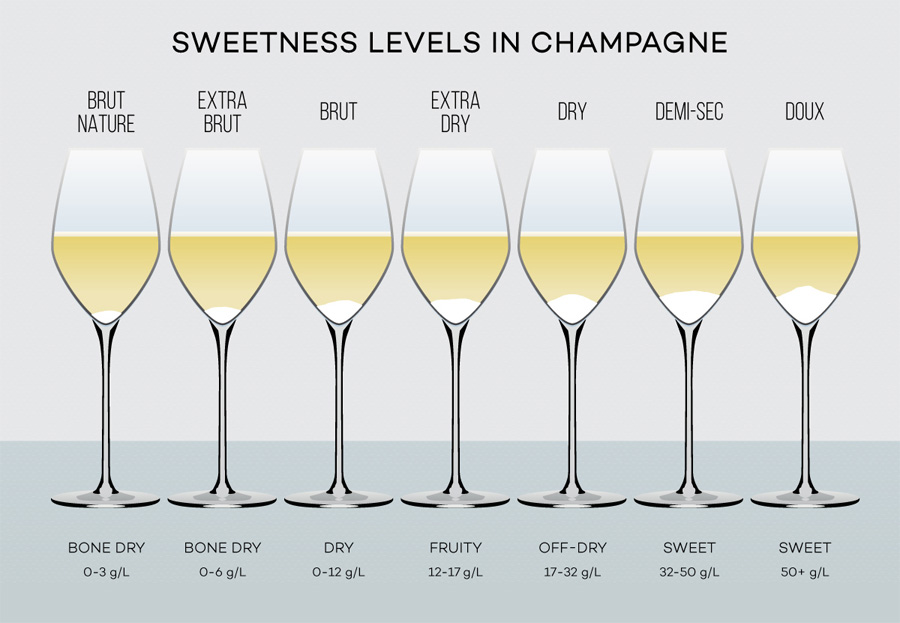
SWEETNESS
Different styles of Champagne, and indeed most sparkling wines in general, are classified by how sweet or dry they are. It is measured by the amount of sugar in grams per litre (g/L) found in the wine. This can either be residual from the fermentation process or by the further addition of sugar. The official classifications for styles are as follows:
Zero Dosage
Between 0g and 3g of sugar. While a tiny amount of sugar is permissible, this style usually has no added sugar and any found will be residual from the winemaking process. It is considered to be the purest expression of Champagne and as such it is sometimes referred to as 'Champagne without makeup'. It is also referred to as Brut Nature or Brut Zero.
Extra Brut
Between 0g and 6g of sugar. There is some overlap here with the Zero Dosage and Brut classification, and may be used by some Champagne houses to denote that this wine style is drier than a Brut offering.
Brut
Between 0g and 12g of sugar. The most popular style of Champagne today. There still remains overlap with Zero Dosage and Extra Brut classifications and those styles would be permitted to be labelled as Brut. This dry style accounts for the majority of all Champagne production.
Extra Sec
Between 12g and 17g of sugar. Also known as Extra Dry. A slightly sweeter style and considerably less popular than Brut.
Sec
Between 17g and 32g of sugar. Sec is the French word for "Dry" and rather counter-intuitively is one of the sweeter styles of Champagne. This stems from historic tastes which were considerably sweeter than today. By past standards, a wine with this amount of sugar would have been a dry style!
Demi-Sec
Between 32g and 50g of sugar. Semi-Dry, which again only makes sense when you consider the historical context as this is one of the sweetest modern styles. It’s the most popular sweeter style.
Doux
Over 50g of sugar. Not commonly found. It’s one for those with a sweet tooth. Having said that, many of our ancestors would still likely have found this a rather dry style!
To make sense of calling all the styles some variant of "dry", it helps to look at past tastes. Throughout the 19th century, Champagne was instead classified by their intended destination.
Goût Anglais - The "English Taste", which contained between 22g and 66g of sugar per litre.
Goût Americain - The "American Taste", which contained between 110g and 165g of sugar per litre.
Goût Français - The "French Taste", which contained between 165g and 200g of sugar per litre.
Goût Russe - The "Russian Taste", which was between 200g and 300g of sugar per litre.
During Champagne's early days, the styles we would consider extremely sweet today, would have been some of the driest styles in existence. By contrast, the idea of a champagne with 200g or more sugar per litre in a bottle of Champagne today is utterly unfathomable.
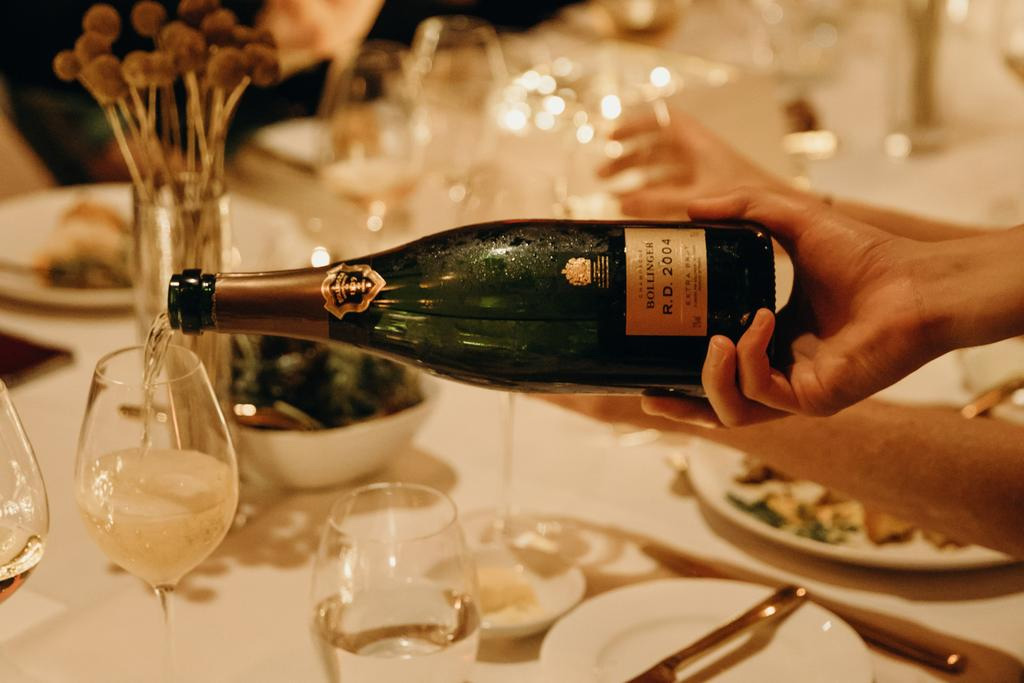
SERVING CHAMPAGNE
Temperature
Champagne should always be served chilled; the optimal serving temperature is between 5°C to 10°C (41 to 50°F). This should give a drinking temperature of between 8°C to 13°C, once it has warmed up in the glass. A champagne bucket filled with ice can be useful in achieving this. However the best way to chill is in a fridge. This helps to achieve a constant temperature throughout the wine. An ice bucket will only cool the wine nearest the glass first before penetrating to the rest of the wine in the bottle. In addition to wine tasting its best when cooled, chilling also serves to stabilise the wine making it less likely to foam out upon opening.
.jpg)
Uncorking
Where many producers of still wines have adopted a more modern screw cap for bottles, champagne uses a traditional cork, requiring a more specialised technique to remove. After removing the wire and foil, hold the cork firmly in one hand and the bottle with the other. Ideally holding the bottle at an angle, gently twist the bottle, not the cork itself, slowly working the cork free. If the bottle has been kept well chilled and not agitated, none of the wine should spout forth, but in the event it does, patting the top of the bottle with the cork, though not attempting to seal it again, should subdue the foam.
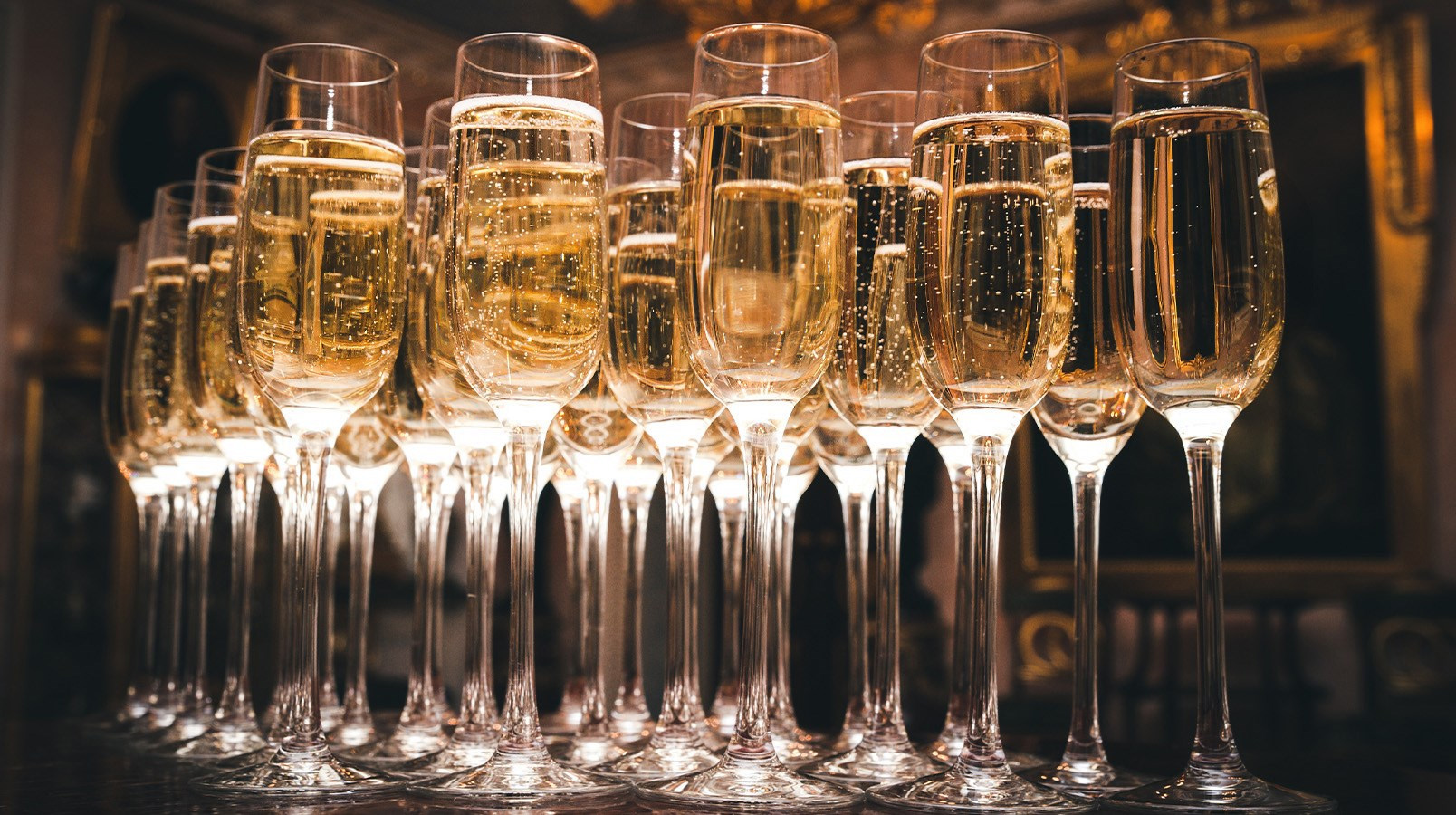
Glassware
Generally, there are three types of glasses used for serving Champagne. The iconic tall, slim Flute Glass is the most common type found. Flutes are always classy, and excellent for preserving the all-important bubbles in Champagne. Historically, Coupe Glasses were the most popular choice, with a shallow bowl and wide rim. This style of glass has fallen out of favour in more recent times as the wide surface area allows the bubbles to dissipate too quickly. Coupe glasses may be suitable when the Champagne is to be drunk immediately upon serving, but if the glass is to stand for any time, it is far from ideal. The traditional Wine Glass has in recent time been gaining in popularity, with a wider bowl than the Flute and tapering towards the rim. It is the glass of choice for purists and at tastings, as the shape is specifically designed to enhance the flavours and aromas of the wine.
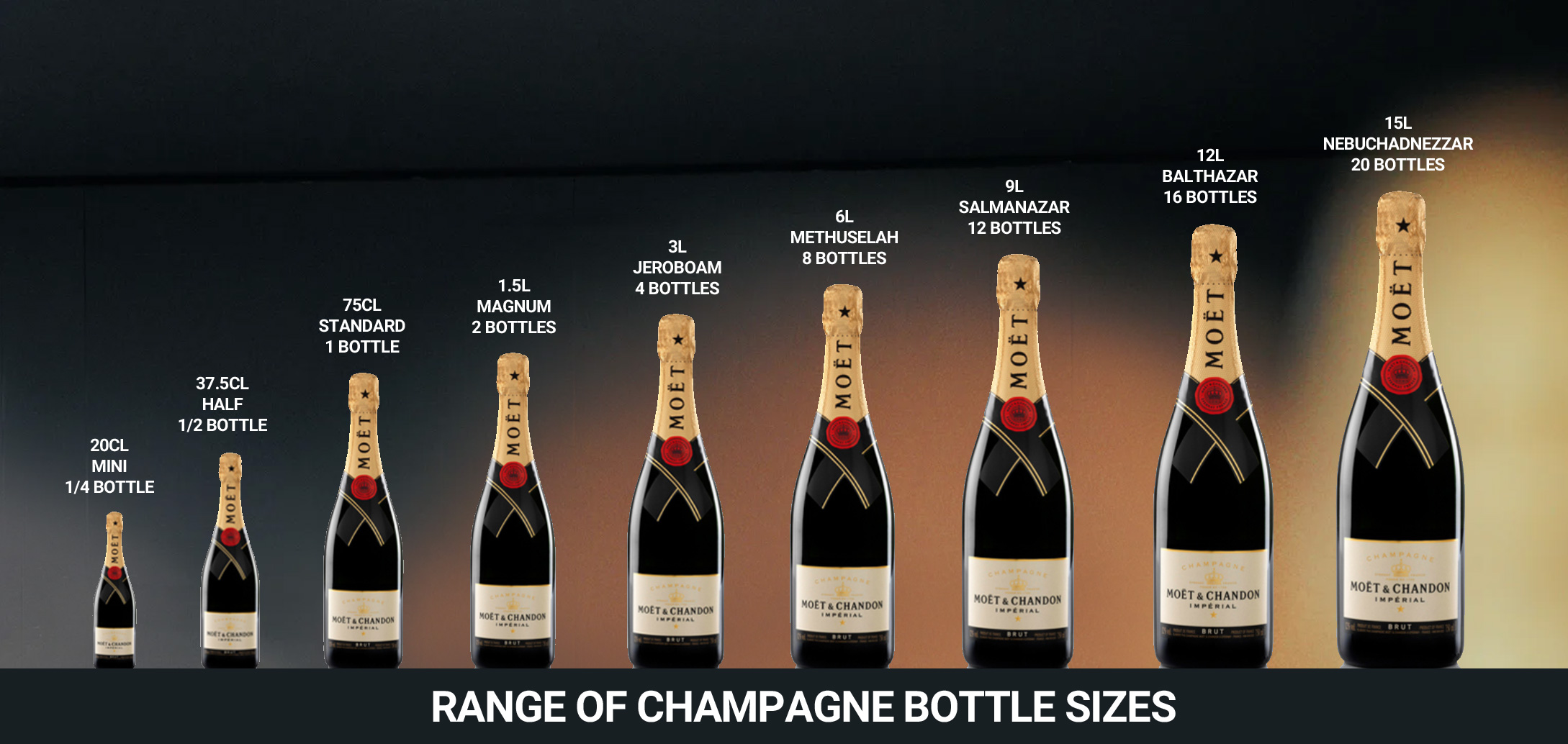
CHAMPAGNE BOTTLE SIZES
The majority of champagne is sold in the 75cl bottles. Some Champagne Houses offer a small number of larger format bottles. These range from the big to the huge! They typically cost more than the equivalent 75cl bottle, but make for an excellent centre-piece bottle for an event or occasion and certainly create a talking point!
GLASS SERVINGS PER BOTTLE
In the table below is shown the typical number of glasses each bottle size can serve based on a 125ml serve:
|
Size |
Bottle Volume |
Standard Bottle |
Number of Glasses |
|
Mini |
20cl |
1/4 |
1.5 |
|
Half |
37.5cl |
1/2 |
3 |
|
Standard |
75cl |
1 |
6 |
|
Magnum |
1.5 litre |
2 |
12 |
|
Jeroboam |
3 litre |
4 |
24 |
|
Methuselah |
6 litre |
8 |
48 |
|
Salmanazar |
9 litre |
12 |
72 |
|
Balthazar |
12 litre |
16 |
96 |
|
Nebuchadnezzar |
15 litre |
20 |
120 |
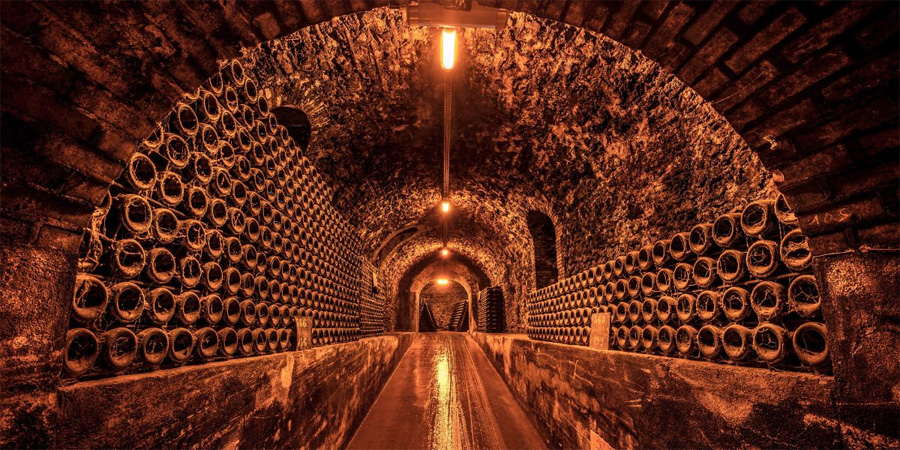
CARE and STORAGE
While all champagnes will be ready for drinking upon release by a producer, as it would already have matured it for several years in their cellars, many of the finest champagnes will continue to age gracefully. At the non-vintage end of the champagne market it is usually recommended to drink the wine early. However, experience has shown that even non-vintage champagne have the potential to develop further complexity through ageing and careful storage for up to 2-3 years after purchase and sometimes longer. Vintage releases and especially Prestige Cuvées have the potential to be aged for many more years if stored correctly.
This is illustrated particularly well by the excavation of a shipwreck in the Baltic Sea in 2010, which was found to contain 168 bottles of Champagne, which analysis showed included 46 bottles of Veuve Clicquot thought to pre-date 1825. The combination of water pressure, cold temperature and total darkness created ideal conditions to preserve the Champagne to a high standard for almost 200 years and tasters discovered hints of lime and honey.
Storage at the bottom of the ocean is impractical solution for many wine collectors and so in a more traditional cellar there are 5 basic factors involved in care and storage of Champagne to ensure it appreciates in gastronomic value:
Temperature - The exact temperature is not a significant concern in wine storage, more so that the temperature is kept as constant as possible. Temperature anywhere from 7°C to 18°C is acceptable, though between 10°C and 13°C is optimal. Storing at a higher temperature can cause the wine to age too rapidly, and temperature fluctuations can reduce the effectiveness of the cork seal through expansion and contraction, letting oxygen in.
Light - Bright light and in particular sunlight has a harmful effect over a period of time on wine generally, but even more so in Champagne. The ultra-violet radiation can create free radicals in the wine and lead to premature oxidation.
Stability - Common wisdom suggests that vibrations can have the effect of accelerated ageing in wine, though much of this was anecdotal. A 2008 study however concluded that vibrations in most instances led to negative effects on wine quality, so vibrations should be minimised during storage.
Humidity - A degree of humidity is required for optimal Champagne storage. The use of a traditional cork in sealing the bottle means excessively dry storage conditions will dry out and shrink the cork, letting air into the wine. Equally, damp conditions can have a harmful effect, as this can damage wine labels and encourage fungus. Experts suggest a humidity of up to 75% to be reasonable, but this is not an area which has been researched extensively.
Position - Champagne bottles should always be stored lying down with their labels upper-most. This allows the wine to be identified without being disturbed and keeps the wine in contact with cork, preventing it drying out and spoiling the contents.

